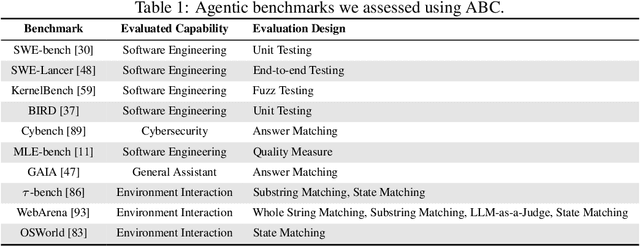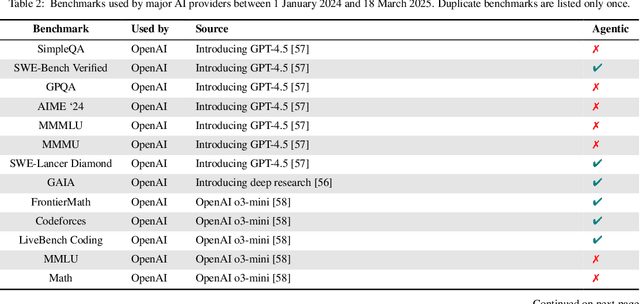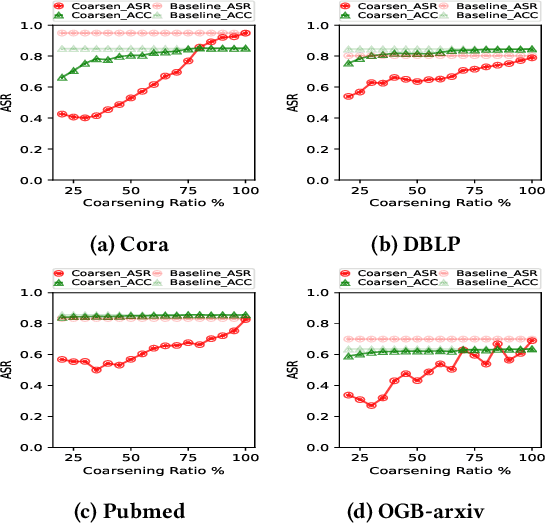Yuxuan Zhu
Establishing Best Practices for Building Rigorous Agentic Benchmarks
Jul 03, 2025



Abstract:Benchmarks are essential for quantitatively tracking progress in AI. As AI agents become increasingly capable, researchers and practitioners have introduced agentic benchmarks to evaluate agents on complex, real-world tasks. These benchmarks typically measure agent capabilities by evaluating task outcomes via specific reward designs. However, we show that many agentic benchmarks have issues task setup or reward design. For example, SWE-bench Verified uses insufficient test cases, while TAU-bench counts empty responses as successful. Such issues can lead to under- or overestimation agents' performance by up to 100% in relative terms. To make agentic evaluation rigorous, we introduce the Agentic Benchmark Checklist (ABC), a set of guidelines that we synthesized from our benchmark-building experience, a survey of best practices, and previously reported issues. When applied to CVE-Bench, a benchmark with a particularly complex evaluation design, ABC reduces the performance overestimation by 33%.
Breaking Barriers: Do Reinforcement Post Training Gains Transfer To Unseen Domains?
Jun 24, 2025Abstract:Reinforcement post training (RPT) has recently shown promise in improving the reasoning abilities of large language models (LLMs). However, it remains unclear how well these improvements generalize to new domains, as prior work evaluates RPT models on data from the same domains used for fine-tuning. To understand the generalizability of RPT, we conduct two studies. (1) Observational: We compare a wide range of open-weight RPT models against their corresponding base models across multiple domains, including both seen and unseen domains in their fine-tuning data. (2) Interventional: we fine-tune LLMs with RPT on single domains and evaluate their performance across multiple domains. Both studies converge on the same conclusion that, although RPT brings substantial gains on tasks similar to the fine-tuning data, the gains generalize inconsistently and can vanish on domains with different reasoning patterns.
UTBoost: Rigorous Evaluation of Coding Agents on SWE-Bench
Jun 10, 2025Abstract:The advent of Large Language Models (LLMs) has spurred the development of coding agents for real-world code generation. As a widely used benchmark for evaluating the code generation capabilities of these agents, SWE-Bench uses real-world problems based on GitHub issues and their corresponding pull requests. However, the manually written test cases included in these pull requests are often insufficient, allowing generated patches to pass the tests without resolving the underlying issue. To address this challenge, we introduce UTGenerator, an LLM-driven test case generator that automatically analyzes codebases and dependencies to generate test cases for real-world Python projects. Building on UTGenerator, we propose UTBoost, a comprehensive framework for test case augmentation. In our evaluation, we identified 36 task instances with insufficient test cases and uncovered 345 erroneous patches incorrectly labeled as passed in the original SWE Bench. These corrections, impacting 40.9% of SWE-Bench Lite and 24.4% of SWE-Bench Verified leaderboard entries, yield 18 and 11 ranking changes, respectively.
Embed Progressive Implicit Preference in Unified Space for Deep Collaborative Filtering
May 28, 2025Abstract:Embedding-based collaborative filtering, often coupled with nearest neighbor search, is widely deployed in large-scale recommender systems for personalized content selection. Modern systems leverage multiple implicit feedback signals (e.g., clicks, add to cart, purchases) to model user preferences comprehensively. However, prevailing approaches adopt a feedback-wise modeling paradigm, which (1) fails to capture the structured progression of user engagement entailed among different feedback and (2) embeds feedback-specific information into disjoint spaces, making representations incommensurable, increasing system complexity, and leading to suboptimal retrieval performance. A promising alternative is Ordinal Logistic Regression (OLR), which explicitly models discrete ordered relations. However, existing OLR-based recommendation models mainly focus on explicit feedback (e.g., movie ratings) and struggle with implicit, correlated feedback, where ordering is vague and non-linear. Moreover, standard OLR lacks flexibility in handling feedback-dependent covariates, resulting in suboptimal performance in real-world systems. To address these limitations, we propose Generalized Neural Ordinal Logistic Regression (GNOLR), which encodes multiple feature-feedback dependencies into a unified, structured embedding space and enforces feedback-specific dependency learning through a nested optimization framework. Thus, GNOLR enhances predictive accuracy, captures the progression of user engagement, and simplifies the retrieval process. We establish a theoretical comparison with existing paradigms, demonstrating how GNOLR avoids disjoint spaces while maintaining effectiveness. Extensive experiments on ten real-world datasets show that GNOLR significantly outperforms state-of-the-art methods in efficiency and adaptability.
ELT-Bench: An End-to-End Benchmark for Evaluating AI Agents on ELT Pipelines
Apr 07, 2025Abstract:Practitioners are increasingly turning to Extract-Load-Transform (ELT) pipelines with the widespread adoption of cloud data warehouses. However, designing these pipelines often involves significant manual work to ensure correctness. Recent advances in AI-based methods, which have shown strong capabilities in data tasks, such as text-to-SQL, present an opportunity to alleviate manual efforts in developing ELT pipelines. Unfortunately, current benchmarks in data engineering only evaluate isolated tasks, such as using data tools and writing data transformation queries, leaving a significant gap in evaluating AI agents for generating end-to-end ELT pipelines. To fill this gap, we introduce ELT-Bench, an end-to-end benchmark designed to assess the capabilities of AI agents to build ELT pipelines. ELT-Bench consists of 100 pipelines, including 835 source tables and 203 data models across various domains. By simulating realistic scenarios involving the integration of diverse data sources and the use of popular data tools, ELT-Bench evaluates AI agents' abilities in handling complex data engineering workflows. AI agents must interact with databases and data tools, write code and SQL queries, and orchestrate every pipeline stage. We evaluate two representative code agent frameworks, Spider-Agent and SWE-Agent, using six popular Large Language Models (LLMs) on ELT-Bench. The highest-performing agent, Spider-Agent Claude-3.7-Sonnet with extended thinking, correctly generates only 3.9% of data models, with an average cost of $4.30 and 89.3 steps per pipeline. Our experimental results demonstrate the challenges of ELT-Bench and highlight the need for a more advanced AI agent to reduce manual effort in ELT workflows. Our code and data are available at https://github.com/uiuc-kang-lab/ETL.git.
SentenceKV: Efficient LLM Inference via Sentence-Level Semantic KV Caching
Apr 01, 2025Abstract:Large language models face significant computational and memory challenges when processing long contexts. During inference, efficient management of the key-value (KV) cache, which stores intermediate activations for autoregressive generation, is critical to reducing memory overhead and improving computational efficiency. Traditional token-level efficient KV caching methods overlook semantic information, treating tokens independently without considering their semantic relationships. Meanwhile, existing semantic-preserving KV cache management approaches often suffer from substantial memory usage and high time-to-first-token. To address these limitations, we propose SentenceKV, a novel sentence-level semantic KV caching approach designed to enhance inference efficiency while preserving semantic coherence. During prefilling, SentenceKV groups tokens based on sentence-level semantic similarity, compressing sentence representations into concise semantic vectors stored directly on the GPU, while individual KV pairs are offloaded to CPU. During decoding, SentenceKV generates tokens by selectively retrieving semantically relevant sentence-level KV entries, leveraging the semantic similarity between the prefilling-stage semantic vectors and decoding-stage queries. This ensures efficient and contextually accurate predictions, minimizing the loading of redundant or irrelevant data into GPU memory and significantly reducing memory overhead while maintaining stable inference latency, even for extremely long contexts. Extensive evaluations on benchmarks including PG-19, LongBench, and Needle-In-A-Haystack demonstrate that SentenceKV significantly outperforms state-of-the-art methods in both efficiency and memory usage, without compromising model accuracy.
CVE-Bench: A Benchmark for AI Agents' Ability to Exploit Real-World Web Application Vulnerabilities
Mar 21, 2025Abstract:Large language model (LLM) agents are increasingly capable of autonomously conducting cyberattacks, posing significant threats to existing applications. This growing risk highlights the urgent need for a real-world benchmark to evaluate the ability of LLM agents to exploit web application vulnerabilities. However, existing benchmarks fall short as they are limited to abstracted Capture the Flag competitions or lack comprehensive coverage. Building a benchmark for real-world vulnerabilities involves both specialized expertise to reproduce exploits and a systematic approach to evaluating unpredictable threats. To address this challenge, we introduce CVE-Bench, a real-world cybersecurity benchmark based on critical-severity Common Vulnerabilities and Exposures. In CVE-Bench, we design a sandbox framework that enables LLM agents to exploit vulnerable web applications in scenarios that mimic real-world conditions, while also providing effective evaluation of their exploits. Our evaluation shows that the state-of-the-art agent framework can resolve up to 13% of vulnerabilities.
Will Large Language Models be a Panacea to Autonomous Driving?
Sep 24, 2024



Abstract:Artificial intelligence (AI) plays a crucial role in autonomous driving (AD) research, propelling its development towards intelligence and efficiency. Currently, the development of AD technology follows two main technical paths: modularization and end-to-end. Modularization decompose the driving task into modules such as perception, prediction, planning, and control, and train them separately. Due to the inconsistency of training objectives between modules, the integrated effect suffers from bias. End-to-end attempts to address this issue by utilizing a single model that directly maps from sensor data to control signals. This path has limited learning capabilities in a comprehensive set of features and struggles to handle unpredictable long-tail events and complex urban traffic scenarios. In the face of challenges encountered in both paths, many researchers believe that large language models (LLMs) with powerful reasoning capabilities and extensive knowledge understanding may be the solution, expecting LLMs to provide AD systems with deeper levels of understanding and decision-making capabilities. In light of the challenges faced by both paths, many researchers believe that LLMs, with their powerful reasoning abilities and extensive knowledge, could offer a solution. To understand if LLMs could enhance AD, this paper conducts a thorough analysis of the potential applications of LLMs in AD systems, including exploring their optimization strategies in both modular and end-to-end approaches, with a particular focus on how LLMs can tackle the problems and challenges present in current solutions. Furthermore, we discuss an important question: Can LLM-based artificial general intelligence (AGI) be a key to achieve high-level AD? We further analyze the potential limitations and challenges that LLMs may encounter in promoting the development of AD technology.
On the Robustness of Graph Reduction Against GNN Backdoor
Jul 02, 2024



Abstract:Graph Neural Networks (GNNs) are gaining popularity across various domains due to their effectiveness in learning graph-structured data. Nevertheless, they have been shown to be susceptible to backdoor poisoning attacks, which pose serious threats to real-world applications. Meanwhile, graph reduction techniques, including coarsening and sparsification, which have long been employed to improve the scalability of large graph computational tasks, have recently emerged as effective methods for accelerating GNN training on large-scale graphs. However, the current development and deployment of graph reduction techniques for large graphs overlook the potential risks of data poisoning attacks against GNNs. It is not yet clear how graph reduction interacts with existing backdoor attacks. This paper conducts a thorough examination of the robustness of graph reduction methods in scalable GNN training in the presence of state-of-the-art backdoor attacks. We performed a comprehensive robustness analysis across six coarsening methods and six sparsification methods for graph reduction, under three GNN backdoor attacks against three GNN architectures. Our findings indicate that the effectiveness of graph reduction methods in mitigating attack success rates varies significantly, with some methods even exacerbating the attacks. Through detailed analyses of triggers and poisoned nodes, we interpret our findings and enhance our understanding of how graph reduction interacts with backdoor attacks. These results highlight the critical need for incorporating robustness considerations in graph reduction for GNN training, ensuring that enhancements in computational efficiency do not compromise the security of GNN systems.
FedTrans: Efficient Federated Learning via Multi-Model Transformation
Apr 25, 2024Abstract:Federated learning (FL) aims to train machine learning (ML) models across potentially millions of edge client devices. Yet, training and customizing models for FL clients is notoriously challenging due to the heterogeneity of client data, device capabilities, and the massive scale of clients, making individualized model exploration prohibitively expensive. State-of-the-art FL solutions personalize a globally trained model or concurrently train multiple models, but they often incur suboptimal model accuracy and huge training costs. In this paper, we introduce FedTrans, a multi-model FL training framework that automatically produces and trains high-accuracy, hardware-compatible models for individual clients at scale. FedTrans begins with a basic global model, identifies accuracy bottlenecks in model architectures during training, and then employs model transformation to derive new models for heterogeneous clients on the fly. It judiciously assigns models to individual clients while performing soft aggregation on multi-model updates to minimize total training costs. Our evaluations using realistic settings show that FedTrans improves individual client model accuracy by 14% - 72% while slashing training costs by 1.6X - 20X over state-of-the-art solutions.
 Add to Chrome
Add to Chrome Add to Firefox
Add to Firefox Add to Edge
Add to Edge